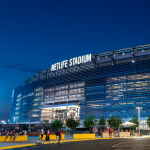
History and Design of the Aviva Stadium
One of the best "bowl" stadiums will be the Europe League stage
May 21st, 2024
Atalanta-Bayer Leverkusen will be a special match. The 2024 edition of the Europa League final brings together two teams that have surprised with the beauty of their football, united by the desire to seek results through an approach primarily oriented towards the offensive phase. Pressing, movement off the ball, constant advancement-focused passing, continuous search for depth, finishing, and refining even in tight spaces. Atalanta and Bayer Leverkusen are two teams that have reached the pinnacle of European football while remaining faithful to their principles of play. The match they will play on May 22 could potentially be the most beautiful of the entire 2023/24 season, and to make this event even more special, there will be the backdrop of a unique stadium in European football: the Aviva Stadium in Dublin. Officially for UEFA, it will be played at the Dublin Arena, but the substance remains the same; the Europa League final will be held within the most important stadium in all of Ireland, the venue for the home games of the Irish national football and rugby teams.
@stadiumstoriess The largest football stadium in Ireland... #irelandfootball #avivastadium #dublin #crokepark i was only temporary 2 u - my head is empty
The Aviva Stadium was inaugurated in 2010 and is located on the same site as Lansdowne Road, the historic sports facility in Dublin inaugurated in 1872 and demolished in 2007 due to obsolescence. The project for the new facility was designed by the architectural firm Populous, together with Scott Tallon Walker Architects. The final result is a 50,000-seat stadium that has helped redefine the aesthetics of modern football stadiums, being one of the first to propose those voluminous and curved shapes that are now the starting point for every new stadium or renovation work on old facilities. In this case, however, the choice of these sinuous forms is not purely aesthetic but is due to some environmental constraints related to the site where the Aviva Stadium was built. The area is surrounded by houses and buildings constructed over the years around the old facility, an adjacent railway line, and the River Liffey. Hence the decision to design a curvilinear but irregular facility, a sort of wave that first ripples and then dips.
@theirishindependent The atmosphere at the Aviva Stadium was a big talking point on the latest episode of The Left Wing, in association with @Bank of Ireland original sound - Irish Independent
The final result is a stadium that from the outside gives the impression of a bowl, as we are used to today, while from the inside, the choice of building the facility on a horseshoe-shaped plan is clear. The two central stands, the west side and the east side, are built on multiple levels and reach the highest points of the facility. The north and south sides, on the other hand, have a lower capacity, particularly the north side, which is the horizontal section that ideally closes the horseshoe and includes a small stand on one level only. Thanks to this solution, Populous was able to build a lower structure on the north and south sides, minimizing inconvenience to the surrounding residences. Additionally, the cladding was made with transparent panels that do not obstruct the passage of sunlight towards the adjacent houses and that give the stadium a different color depending on the natural light that reflects on the panels. In short, the Aviva Stadium is truly special. A stadium unique in its kind, and we couldn't wish for a better location for one of the most anticipated matches of the year.












